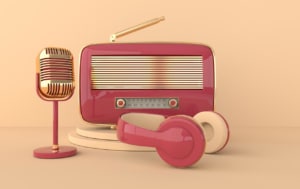What are wireless headphones?
Wireless headphones are mini speakers that - like ordinary headphones - are worn in or on the ear. Compared to ordinary headphones, however, the wireless headphones can be operated wirelessly.
This means that they receive the signals in digital or analog form through radio waves, Bluetooth or similar. The small Loudspeakers can be purchased as wireless headphones for TV or used for music.
Wireless headphones can be used wherever you want to listen to music or watch TV undisturbed (or without disturbing others). A typical area of application for wireless headphones is also for sports, such as jogging.
How do wireless headphones work?
Wireless headphones work on the basis of wireless transmission. In contrast to a conventional headphone, this will Signal i.e. not using a cable, but using radio technology.
The signal is emitted by a transmitter and picked up again by the receiver, i.e. the wireless headphones. At the same time, the signal is converted into sound, which the human ear perceives as Ton is perceived.
Compared to the linear signal of headphones with a cable, the signal in a wireless headphone test is much more flexible. Because you are not tied to a cable, the wireless headphones do not restrict your freedom of movement as much.
However, a wireless headphone test made it clear that the range is not as great as originally thought. The actual range, as was also proven by the wireless headphone test, depends on the power of the transmitter and receiver. In addition, disruptive factors such as walls also play a role in this range.
The transmitters of a wireless headphone can vary. In a TV headphone test, in which wireless headphones for televisions were tested, it has been shown that the wireless headphones usually have a transmitter that is compatible with numerous connections.
This includes, for example, a Toslink Connection, Klinke- Connections in different sizes, Cinch-connectors or audio coaxial connectors.
On the other hand, as can be read in another article, a wireless headphone test that only took into account the Bluetooth-based mini speakers found that it is particularly practical if the Bluetooth interface is already present as a transmitter on the device is, because in this way one can completely dispense with the use of a transmitting station.
Advantages & areas of application of wireless headphones
The wireless headphones are therefore considered a replacement for conventional headphones for televisions, smartphones or HiFi-Device that need to be connected with a cable. The disadvantage of wired headphones compared to wireless headphones is of course immediately apparent.
Because with the wireless headphones you have a greater range and don't have to worry about the headphones getting stuck somewhere.
Because it is very common to use headphones when doing sports – especially when jogging. With the headphones without a cable, you no longer have to worry so quickly about getting caught on a branch or the cable getting caught in your own clothing and being pulled out of your ear, so to speak, by your own body movement.
But the wireless headphones also have their advantages as headphones for TV, as a TV headphone test shows. Because nothing is more pleasant than sitting back and relaxing in the evening watching TV - without having to worry about pulling the plug out of the socket on the TV.
It is also practical that the transmitting stations for wireless headphones usually have more than one connection option, as was shown by a wireless headphone test. Of course, it is also practical if the devices and the headphones have their own Bluetooth interface, so that no transmitter station is required at all.
The advantages of wireless headphones at a glance
- Flexible connection options
- Reduced risk of accidents in sports
- Greater range
What should I look out for when buying wireless headphones?
When buying headphones with a wireless function, you should not only make sure that the headphones performed well in a wireless headphone test from 2017, 2018 or later.
You should also make sure that the wireless headphones also suit your needs. Because if you want headphones for the TV, you need different headphones with a wireless function than if you want to use the wireless headphones for jogging, for example.
As guidelines to consider before purchasing, you can refer to the following:
1) Type of radio transmission and connections:
In any case, you should note what type of wireless transmission you need and what type of wireless headphones offer you. Because if you want to use the headphones for a TV that is relatively old, you can assume that the TV does not yet have a Bluetooth interface.
Such headphones with a wireless function then fail, for example. On the other hand, if you only want to use the headphones for your smartphone when you are out and about, Bluetooth seems to be the best alternative.
For older consumer electronics devices, it is advisable to check the connections carefully so that you can also be sure that you are purchasing headphones with a wireless function that can later be used on your devices.
2) Design of the transmitting station:
If you decide on headphones for a TV set or only want to use the headphones with wireless function in the house, then you can also think about how the transmitting station should be designed for optical reasons.
A lot of these stations have a nice design and you could already think about where you want to put the headphones later.
3) Range:
If you only want to sit on the sofa at home with the headphones for the TV, from which the TV is only a few meters away, you probably don't have to worry about the range of your wireless headphones.
In a test for wireless headphones, it was found that the range of wireless headphones rarely reaches what the manufacturer specifies. Because the manufacturer's specifications often contain information such as a range of 100 meters.
However, the wireless headphone test from 2017 shows that this information is deceptive and that a maximum of 30 meters should be expected.
4) Battery life:
Imagine the following: you have finally bought your dream wireless headphones for your TV set. Your favorite movie is on and it's just getting really exciting. At the same moment it happens: the battery of your headphones is empty.
To prevent such a scenario from happening, you should definitely pay attention to the battery life of your headphones. Also, some headphones give you the flexibility of being open to both battery and battery.
FAQ about wireless headphones
1) Which are the best wireless headphones for a TV?
In a current test for wireless headphones or in a wireless headphone test from 2017 or 2018 you can read which wireless headphones are best suited for a TV set. In addition, you should consider a few other criteria that are important for your personal needs.
2) Which is the best wireless headphones for jogging?
Especially light and small wireless headphones are best suited for jogging, which cannot be thrown out of the ear even with the vibration caused by the rhythmic running.
There are also some in-ear plugs that are plugged directly into the ear and therefore cannot fall out of the ear so easily. In a wireless headphone comparison from 2018, it is pointed out that there are also special wireless headphones that were specially designed for sports activities.
3) When are wireless headphones with Bluetooth worth it?
Wireless headphones with Bluetooth are particularly worthwhile if you only have newer technical devices that can be paired with Bluetooth without any problems.
In addition, with a digital transmission type, it is also important to consider the transmission sources. Because if these are analogue, an analogue type of transmission is more suitable.
What types of wireless headphones are there?
With wireless headphones, various subdivisions can be made. Wireless headphones can be classified in terms of the type of transmission and in terms of the shape of the headphones.
The type of transmission can be either analogue or digital.
Analog wireless headphones
With analog wireless headphones, the signals are transmitted using radio waves. Usually, the radio waves are transmitted by means of FM forwarded and transmitted by a so-called FMdemodulator converted into an audio signal.
The analog wireless headphones mostly work on the basis of a rechargeable battery as the energy source. Even if analogue is often equated with conventional and non-modern these days, it can still be said that the wireless headphones did not do badly in the test.
Because compared to digital wireless headphones, analog wireless headphones have a number of advantages to offer.
For example, no interference from other digital signals is possible. In the test, digital wireless headphones, for example, are extremely susceptible to WLAN networks, which are increasingly found in all facilities or even outdoors.
Analog wireless headphones, on the other hand, are completely unimpressed by the WLAN networks.
Another advantage of the analog wireless headphones in the test is that they can deliver higher sound quality even if the audio source is analog.
Because that way, no A/D conversion has to take place, as it would have to happen with digital wireless headphones. This is usually accompanied by losses and thus also affects the quality of the sound.
Despite these advantages, it should not be concealed that the analog wireless headphones also have massive disadvantages in the test: Because with analog wireless headphones, a kind of background noise can always be determined.
For technical reasons, this background noise cannot be avoided with analog wireless headphones. However, the noise is not perceived by all users of the headphones used wirelessly in the test. Because the analog wireless headphones are also about the sensitivity the user.
But the construction and the technical elements that were built into the wireless headphones also have an influence on the intensity of the noise. Those who like loud music will probably not notice the background noise either when the headphones are tested wirelessly.
Because the background noise is usually so quiet that it can be drowned out by slightly louder music.
Digital wireless headphones
As the name suggests, digital wireless headphones work with digital forms of transmission. Bluetooth, for example, can be considered to be a common transmission. However, the signal must first be converted into an analogue signal.
For this is a D/A converter necessary, which is usually in the headphones themselves. A so-called signal or quiet noise can also be perceived with the digital wireless headphones.
Because the converter is as close as possible to the Loudspeakers seated, this noise can be minimized enormously. In addition, analog sources also require A/D conversion, which has a negative impact on quality.
With digital headphones that are wireless, the test for wireless headphones makes it clear that the Loudspeakers in miniature format are highly sensitive to numerous sources of interference.
For example, headphones that are wireless cannot convince in the test because there are massive transmission difficulties as soon as you are too far away, buildings interfere with the transmission or competing signals get in the way of the Fink headphones.
However, the manufacturer can also do something about the digital wireless headphones. However, the measures are usually not particularly cheap, so the high-quality headphones that were tested wirelessly in a test were consistently very expensive.
Types of wireless headphones divided by shape:
In ear headphones
In-ear headphones are headphones that are small enough to fit in the ear canal. At the same time, the in-ear headphones block out annoying noises. A bracket that is stretched across the head to hold the headphones is not necessary with this type of headphones.
What is practical about this type of headphone is that it cannot slip out of the ear so easily. As shown in a wireless headphone test, the in-ear headphones are ideal for jogging.
Earbud Headphones
Earbud headphones are placed in the auricle. They therefore do not shield the ambient noise quite as much as the in-ear headphones. In a wireless headphone test in 2017, some people described that they found the earbuds much more comfortable in the ear.
For sports, i.e. when jogging, the disadvantages of the earbuds also become apparent. Because the headphones tend to slip out of the ear. Especially when it comes to wireless headphones on a radio basis, this is of course extremely impractical when jogging - because then you can start looking for your headphones first.
On-Ear Headphones
On-ears are headphones that rest on the entire auricle. Since these headphones are larger than the in-ears, it is easier for manufacturers to build good technology into the headphones given the technical fundamentals, so that the sound from the on-ear headphones is usually of higher quality.
However, as a wireless headphone test from 2017 found out, some people find wearing the on-ears annoying after a certain time because the pressure of the headband on the head is too great.
Over-ear headphones
The over-ears are also headband headphones, just like the on-ears. The difference here is that the over-ears enclose the entire ear. Ambient noise is also shielded and you don't have to turn up the volume as loud as with on-ear headphones, for example.
However, in a 2017 wireless headphone test, users complained that you could sweat a lot under the over-ears. Sound experts also point out that the over-ear headphones are technically so sophisticated that they could be "too much of a good thing" for a smartphone.
So the headphones are more for home cinema or home hi-fi systems. In a TV headphone test, this type of headphone occupied the upper ranks in the leaderboard.
This is how wireless headphones were tested
No wireless headphone test is like the other. In the tests, other criteria are used again and again. For example, in a wireless headphone test by "test experts", which was updated in 2019, primarily those aspects that are specified by the manufacturers are taken into account.
In this case, the following criteria apply:
Weight
Of course, headphones should be as light as possible, because you don't want to walk around with a heavy load on your head. Here you can find headphones under 100 grams as well as those that weigh 300 grams and more, explains the wireless headphone test 2018.
Size:
If you want to take your headphones with you and the device should then fit in the smallest pocket, you are better off with headphones that are as compact as possible.
On the other hand, this test criterion is not that important if you only want to leave the headphones at home anyway, as is logically recorded in a TV headphone test.
Type of shape/wearing style
The different forms and their advantages and disadvantages have already been discussed. However, you should also consider what optical effect the headphones can have. If you want to buy your wireless headphones primarily for on the go, then you are certainly very anxious to be able to call a particularly beautiful pair of headphones your own.
After all, you have to be on the road with it every day. In a wireless headphone test 2018, this aspect is particularly emphasized.
Reach
The range is a particularly important criterion if you want to walk through the whole house with the headphones or maybe even go out into the garden. However, there are very big differences in the products, explains the wireless headphone test 2018.
Some manufacturers claim their device has a range of 100m, others claim their device has a range of only 9m.
If you only want to watch TV with your headphones, this aspect is not particularly important to you, as is emphasized in a TV headphone test.
What's in the box
The scope of delivery for the different headphone models includes very different components, as the wireless headphone test 2018 emphasizes.
Some models come with just the bare essentials, while others advertise pockets and loads of extra cables.
In another wireless headphone test, it is pointed out that one should pay attention to whether the manufacturer supplies a second battery.
Other aspects covered by the "expert tests" include the guarantee, sound quality, comfort and durability.
The star bases its test on similar aspects. The Sony mdr-rf895rk was chosen as the winner in the test. In a separate Sony mdr-rf895rk test, it is emphasized that the device is particularly well suited for television, as is also confirmed in a wireless headphone test 2018.
The Sony mdr-rf895rk has been rewarded with good marks mainly because of its carrying comfort and its range.
In addition, the Sony mdr-rf895rk test emphasizes that the device has a better Klang could have, but since the Sony mdr-rf895rk gets a very good price/performance ratio in the test given its low price, the sound can perhaps be viewed somewhat benevolently.
In the wireless headphones test by Stiftung Warentest, other aspects are used to rate the products.
Under the category "This is how we tested it", the wireless headphone test by Stiftung Warentest states that special emphasis was placed on the sound with 55%. Then follows the wireless headphone test by Stiftung Warentest according to the wearing comfort and handling with 25%, the Bluetooth function with 10%, the interference with 5% and the durability with 5%. In the wireless headphones test by Stiftung Warentest, pollutants and the data transmission behavior of the app are also checked.
Where is the best place to buy wireless headphones?
If you are sure that you want to buy new wireless headphones, then you only have to decide where you want to buy the wireless headphones. There are usually two ways to do this: retail and the internet.
To make your decision easier, we have put together some advantages and disadvantages for you: If you want to buy new wireless headphones on the Internet, there are some advantages, but also some disadvantages.
Let's start with the cons: You can't get personal advice on the internet from a real salesman standing right in front of you.
So you can't express any doubts or questions directly. Furthermore, with regard to the wireless headphones' lack of materiality, it can be criticized that neither the design nor the sound can be judged. While you can at least look at the design with the help of photos, you are only dependent on the opinions of others on the Internet when it comes to the sound.
However, we are then already at the advantages, because when buying on the Internet you have insights into customer reviews or a wireless headphone test from 2017, a wireless headphone test from 2018 or even a current test for wireless headphones.
You can compare the best wireless headphones from different years and weigh up which device is actually a good wireless headset. Another advantage is that given the better comparison options, you can also find cheaper prices.
In addition, the selection online is very comprehensive. You may even find models there that would otherwise not be available in Germany and are imported.
The increased right of return on the Internet is also positive: If you are not convinced by the wireless headphones, you can still easily return them.
Advantages of buying online
- Bigger selection
- Better comparisons
- Cheaper prices
- Refund policy
- Research options through tests and comparisons
- Insights into customer reviews
Disadvantages of buying online
- No personal advice
- View by photos only
- No testing possible
Should you decide to buy your wireless headphones from a retail store, then some advantages and some disadvantages will also become apparent.
A clear advantage is that you can get personal advice as needed and sometimes even listen to the wireless headphones to try them out. You can also personally convince yourself of the workmanship and the model.
If you need your wireless headphones for the next day or even for the same day, the advantage of retail also clearly outweighs the disadvantages. Because here you can buy the goods and take them home immediately.
For these advantages, however, you also have to accept some disadvantages. For example, you have no options of comparison.
You cannot use a wireless headphone test to decide which wireless headphone is actually worth its price. Instead, you must rely on the wireless headphone recommendation from the seller.
This recommendation is certainly based on the goods that are sold in the particular retail store - and that is usually not all headphones.
Retail Benefits
- Personal Consulting
- testing on site
- appraisal of the goods
- Purchase from today to tomorrow
Disadvantages in retail
- No comparison possibilities
- Mandatory price with no alternative
- No research options on site
- Dependence on the statement of the seller
- Small selection
If we compare all these disadvantages with the advantages, it can be stated without a doubt that the advantages clearly outweigh the disadvantages on the Internet. Accordingly, we recommend that you buy your wireless headphones online unless you are in a hurry.
Cleaning wireless headphones and accessories
Wireless headphones should be cleaned regularly because - just like clothing - the headphones are constantly in contact with our skin and our body.
In the area of the ear, they not only run the risk of being soiled by sweat, but can also come into contact with earwax, which settles on the headphones. We explain how you can remove the dirt again with the following tips:
The cleaning material
You should always use a dry and lint-free cloth for cleaning. In addition, cotton swabs or toothpicks can be useful for cleaning.
If you have compressed air, this method is also worthwhile, but sometimes it is sufficient if you carefully blow the dirt away. Water and a neutral cleaning agent should only be used for heavy soiling.
It is also important to ensure that the sensitive electronics of the headphones do not come into contact with the water.
You should therefore detach any soiled individual parts from the rest of the wireless headphones as far as possible in order to wash them separately. Experts advise choosing a specific cleaning method for each type of headphone.
In-ear headphones or ear buds
You should definitely clean the in-ear headphones or the ear buds thoroughly, as they sit in or in front of the auditory canal and accordingly often come into contact with earwax.
Since the manufacturers are also aware of this problem, the headphones are usually equipped with attachments made of rubber or silicone or the ear buds with fabric covers that are removable.
Sometimes there is also dirt in the fine grid, which is in front of the actual one Loudspeakers sits. Here you can work carefully with a toothpick. Be careful not to push the dirt further inside, though.
headband headphones
The cleaning of headband headphones is similar in that you should also remove all components of the headphones that can be removed. The upholstery can often be removed and some brands can even be washed.
You should therefore be careful with the rest of the headphones, in which the electronics are installed, and make sure that no water gets into the wireless headphones. Accordingly, it is recommended to clean the headphones with a lint-free microfiber cloth that should be moistened with a few drops of water at the very most.
Sources
https://www.t-online.de/ratgeber/id_85635602/stiftung-warentest-die-besten-buegelkopfhoerer.html




